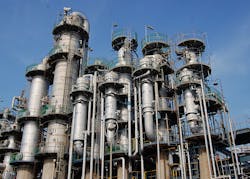Manufacturing executives are embracing intelligent devices at the field level as a way to modernize their large legacy process plants and be proactive in protecting against plant downtime with better maintenance practices. In Japan, Mitsubishi’s Kashima chemical plant has chosen to use intelligent devices and is beginning to use the Field Device Tool (FDT) Frame Application standard to collect information from HART or Foundation Fieldbus-compatible devices and store it in a Yokogawa Plant Resource Manager (PRM) system.
The Kashima facility processes fundamental chemical materials, such as polyethylene or polypropylene for various films, laminations and even car molds. The plant produces, on average, 380,000 tons a year of ethylene.
With that much chemical processing, unscheduled plant shutdowns are expensive. The company estimates the cost of an unscheduled plant shutdown is $600,000 in lost production per day, and a minimum production restart time of five days. Given that, preventing a shutdown/startup cycle saves at least $3 million.
Before this instrument update, Mitsubishi maintenance activities fell into two categories: preventive maintenance and breakdown maintenance, depending on the importance of an instrument in the production and the safety of the plant. Now, a condition-based maintenance strategy allows the company to lean heavily on actionable device data to increase ethylene production.
“The majority of devices at the chemical plant are valves with positioners, flow meters, pressure transmitters and analyzers, such as PH meters,” says Masayuki Yanagisawa, instrument group leader at Kashima for Mitsubishi Chemical.
Data is collected from field devices and integrated into an asset management software via Device Type Manager (DTM) and Electronic Device Description Language (EDDL) configuration methods, which are both supported by the FDT standard. FDT allows systems to access field digital devices from different vendors, collect and manage device parameters from different vendors, and manage the maintenance from different vendors.
For Mitsubishi, this approach immediately reduces common infrastructure and provides the latest and vital device parameters to control rooms before scheduled shutdown maintenance periods. Control rooms now compare parameters before and after shutdown maintenance and improve the maintenance quality for the chemical facility.
“The clear trend is to more advanced diagnostics and prognostics. And faced with declining maintenance resources, plants are looking for ways to increase maintenance efficiency,” says Glenn Schulz, managing director for the FDT Group. “DTM configurations can save trips to the field and indicate when a trip is necessary.”
The DTM profile can include all device-specific data, functions and business rules such as device structure, communication capabilities, internal dependencies and HMI structure. As the FDT Group points out, the DTM method of representing a device is consistent in any FDT Frame Application. The device supplier is in control of the visualization, functionality and advanced features.
Advanced diagnostics
One example of advanced diagnostics at the Kashima plant are the torque metrics for valves, with a maximum torque value being determined by the designed condition of the drive parts. DTM-enabled devices calculate the index of deterioration using these torque metrics and communicate it back to the asset management software.
Another example is the impulse line blocking diagnosis of flow measurement using a differential pressure transmitter from Azbil. “We have had good results testing for freeze detection using field data, such as flow rate, differential pressure, and capsule temperature from the pressure transmitter,” Yanagisawa says.
“DTM diagnostics have also been extended to the industrial network themselves, allowing operators to assess the health of the network—including noise, collisions, retries, etc.—without leaving the control room,” Schulz adds.
However, more data, as seen throughout today’s manufacturing environments, is a challenge to monitor with the same amount of plant personnel. “Currently, various device data is not being analyzed enough,” Yanagisawa says. “The process environment is different for each device and there’s no one answer for all devices.”
Future development
A maintenance approach for device deterioration should also analyze the specific portion of the device data that is influenced by a problem, Yanagisawa says. “Plant personnel are encountering challenges with setting device thresholds for diagnoses and are still searching for the optimum settings.”
The use of plant asset management is expected to improve daily maintenance and operation, and it also should lead to the use of personal digital assistants to collect information. “Currently, device information given to the field personnel is limited,” Yanagisawa says. “Due to the enormous amount of device information provided, however, process control needs to be handled in a centralized room.”
According to the FDT Group, a major end user study is underway to determine what enhancements to the standard will help with mobile strategies.
About the Author
Grant Gerke
Digital Managing Editor

Leaders relevant to this article:
